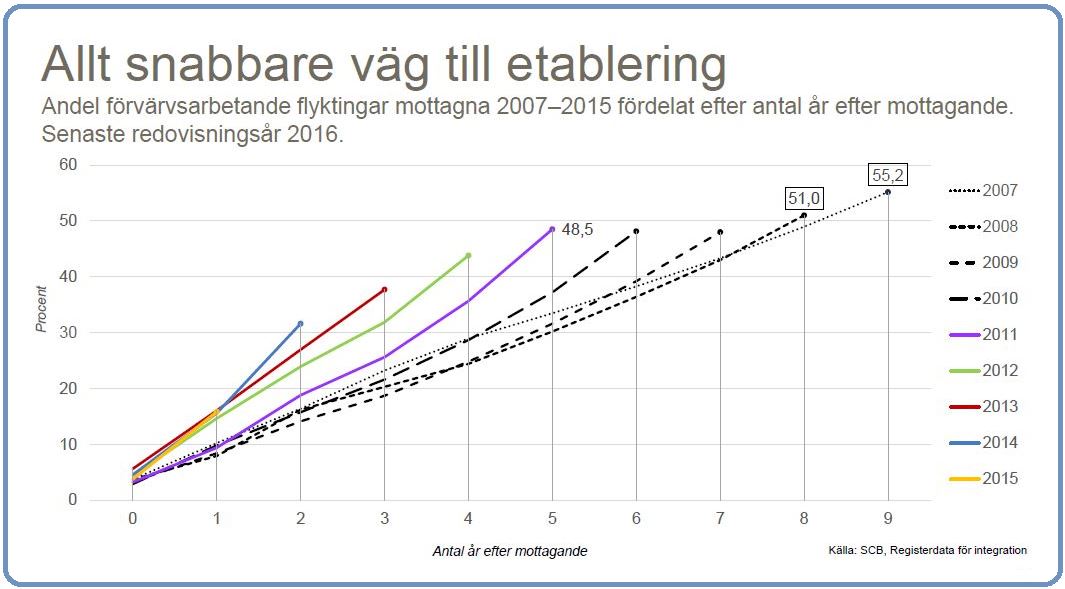Swedish cooperation could half time it takes youths and newly arrived to find work
It takes foreign born jobseekers less time to enter the Swedish labour market than it used to. But some, especially women and people with lower education, still face major challenges. Cooperation on a local level between the Employment Service and municipalities could help.
“The good thing is that things look much better now, and if this trend continues the time it takes foreign born people settling into the labour market will fall from between seven to ten years down to five. But there are still considerable challenges,” Sweden’s Minister for Employment Ylva Johansson told a press conference on 31 January.

The Y axis shows the percentage of refugees who are in paid work, and the X axis shows the number of years since their arrival in Sweden. The time it takes to find work has fallen: For half of the refugees arriving in Sweden in 2007, it took eight years to find a job. Those arriving in 2014 appear to manage in three years
When the current government came to power in September 2014 it quickly expressed a desire to improve cooperation between municipalities and the Employment Service, primarily in order to fight youth unemployment. In December that year, it was decided to establish Delegationen för unga till arbete (the Delegation for young people to work), or Dua. Its task has been to support local agreements between the Employment Service and the municipalities. The idea was that labour market measures aimed at young people would be more efficient if they were localised.
Funds were also made available to help municipalities and the Employment Service figure out how a cooperation might function, before giving economic support to concrete measures. From February 2017, the delegation’s mandate was expanded to include cooperation when it comes to newly arrived citizens.
 “There has always been some cooperation between municipalities and the Employment Service, but for several years the Employment Service was asked to prioritise cooperation with the private sector,” says Lil Ljunggren Lönnberg, who has led Dua since the beginning.
“There has always been some cooperation between municipalities and the Employment Service, but for several years the Employment Service was asked to prioritise cooperation with the private sector,” says Lil Ljunggren Lönnberg, who has led Dua since the beginning.
Long-term cooperation preferred
After the 2014 elections, Ylva Johansson visited municipalities and took part in a range of meetings. One of the questions for the municipalities was: “Do you want to cooperate with the Employment Service?”
“The answer was overwhelmingly positive, as long as the cooperation would be long-term and strong. That is why it has been important to show that the cooperation has been serious. It should form part of daily operations, and there should be structures for cooperation. We have prepared the ground for this, and we see that time is ripe for cooperation,” says Lil Ljunggren Lönnberg.
Dua created models for cooperation, analysed what might have to be done to support the young and created support tools which could be used locally. 287 out of Sweden’s 290 municipalities have entered into agreements with the Employment Service to help unemployed youths. This has allowed them to draw up education contracts and later apply for money for particular development projects. In 2017, Dua granted municipalities a total of 104 million kronor (€10.5m).
When the delegation was also tasked with promoting cooperation for newly arrived citizens, new agreements were signed expanding the cooperation to include them. From 1 March there will be around 250 such agreements. The Employment Service has also strengthened its staff with over 100 new company advisors, and Dua has provided a government grant for municipalities, enabling them to increase support to companies.
“Many employers want to include the newly arrived, but need a ‘back office’. That means they need support and help,” says Lil Ljunggren Lönnberg.
Local job tracks
Municipalities will participate as early as during a newly arrived person’s first conversation, and together with the Employment Service and the individual they will create a roadmap which leads to work or studies. There should be a continuous process where the newly arrived very quickly starts learning Swedish for immigrants, SFI, and some other things.
“The whole idea is to speed up the process, and because cooperation has already been established, this also works for the newly arrived,” she says.
The cooperation has resulted in a range of so-called job tracks. They are built on local employers’ needs for skills, and should make it easier for the newly arrived to get into work quicker. The job tracks empower the newly arrived to learn the skills needed within a certain trade, for instance though workplace training combined with a Swedish language course.
There are many examples. In Ljusdal municipality there is a job track aimed at forestry, where the newly arrived are taught plantation, forestry, crane operation and how to use a chainsaw. In the tourist resort of Åre there is a restaurant track which includes various competencies needed to work in a restaurant kitchen, and where SFI training is combined with vocational Swedish.
Åre also has a nursery track which comprises basic pedagogy, conflict solution and the common values in primary education. Common for all the tracks, which can last up to two years, is that they should lead to seasonal employment.
“We also see that the cooperation between the Employment Service and the municipalities is better an easier than we had hoped for. So far we have established a system for how to work together. Now we want to follow up the things that have led to results,” says Lil Ljunggren Lönnberg.
Still challenges ahead
Youth unemployment has fallen in Sweden in the past year. Numbers presented by the Minister for Employment Ylva Johansson on 31 January also show that the time it takes newly arrived citizens to find work has fallen from between seven to nine years down to five. It is difficult to pinpoint the reason behind this. The booming economy could be one explanation, but the minister also says the way in which refugees are now integrated plays a role, and that there are more education measures in place.
Yet even if things are moving in the right direction, Ylva Johansson pointed out that major challenges remain. One is foreign born women, who are less represented in the labour market than foreign born men. The other is people with low levels of education. It is difficult to enter the Swedish labour market with no upper secondary education, and this applies to both native and foreign born citizens.
“We must find ways of including those who are far removed from the labour market – people with physical handicaps and those who struggle with the language. If the economy turns, they take the first hit and the worst hit. We need to establish seamless access to Komvux (municipal adult education) for young newly arrived citizens, to make sure they get their upper secondary education, while managing economically,” says Lil Ljunggren Lönnberg.
 Follow us on Facebook
Follow us on Facebook
